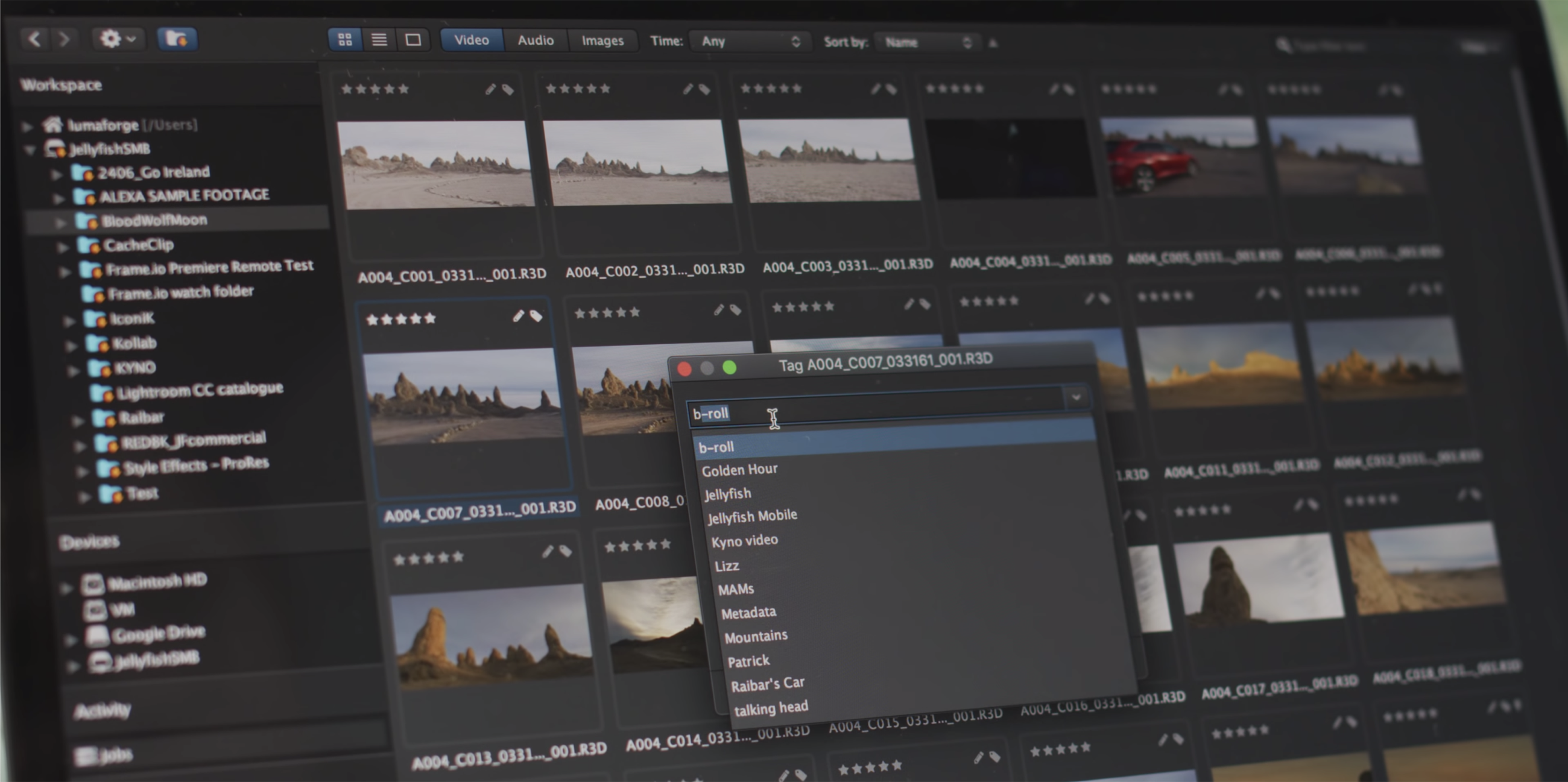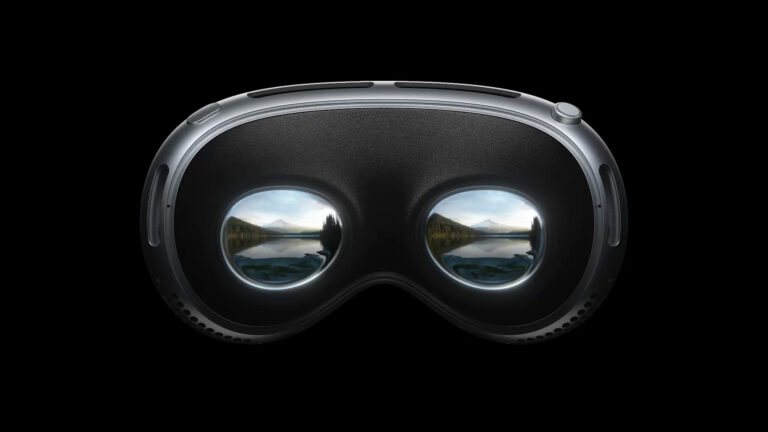In this article series, we’re exploring how large-scale organizations build out digital asset management systems (DAMs) for their video workflows.
We’ve reached out to some of the top experts in the field, with deep experience working with highly complex video workflows. In the first installment, we interviewed Scale Logic about planning out a DAM system. For today’s article, we’re happy to welcome Robert Krüger from Lesspain Software, the makers of Kyno, as he guides us through the ins and outs of DAM strategy.
As you’ll learn below, media management is already forced upon everyone working in professional video production, whether they are aware of it or not. It can become a matter of economic survival for larger projects and organizations, and the topic is complex enough to fill entire books.
This article will provide a simplified yet practical bird’s eye view on media asset management, including the fundamental core concepts. We’ve also made some checklists and guidelines of what to watch out for when introducing new media management strategies and tools into your organization.
DAM, MAM, PAM, and Media Management
To start with a hefty dose of confusion, there simply is no universally accepted definition of these terms with any practical relevance. The terms are used interchangeably quite often, sometimes even in the same sentence. Welcome to the terminology jungle.
“Digital asset management” (DAM), “media asset management” (MAM) or just “media management” are all concerned with the life cycle of digital assets, typically video, audio and image files, and what can be done with them in an organized fashion.
Production asset management (PAM) is a term typically used to describe a subset of systems focused on managing the editing process. Tools like our program Kyno are specifically geared towards work like this.
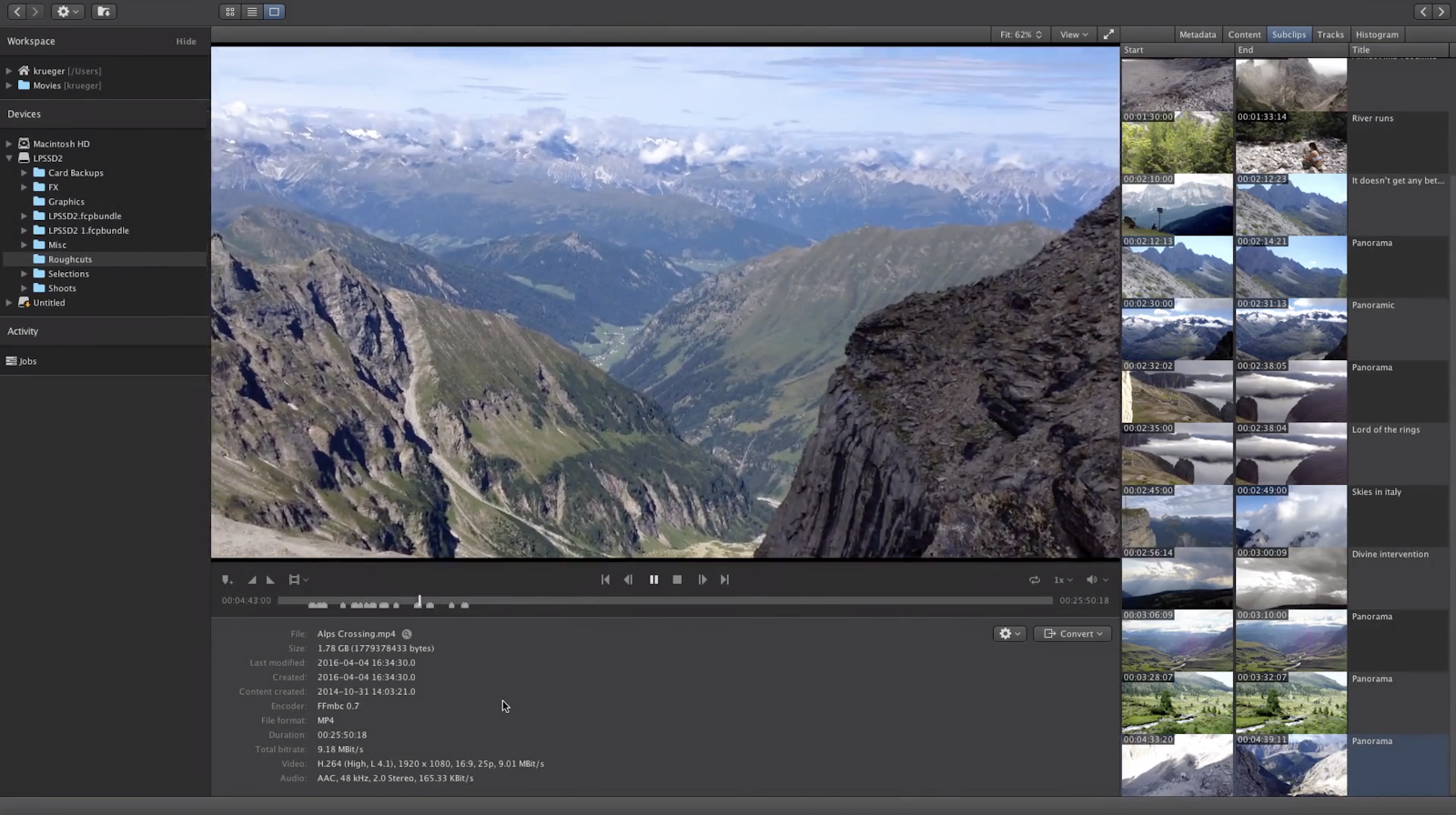
To fully understand these concepts, we also need to parse out the terminology “life cycle.” An asset’s life cycle includes everything from the creation of a file/asset (in a camera or piece of software), to that file’s deletion or archiving, and everything in between. Some of the most common steps in an asset’s life cycle are:
- Verification – Was the file really copied correctly into the system without data errors?
- Quality checks – Is the image/sound “OK” (however that is defined)?
- Metadata management – Extract, enter, or update information about what is actually in the file and its business relevance (e.g. who owns which rights)
- Organization – Categorize, rename, store in folders (depending on the type of system this overlaps with metadata management)
- Retrieval – Find assets based on all available criteria
- Format conversion – e.g. convert from acquisition format to a “house format” or a format suitable for editing or delivery
- Export – Export the entire file, selected subclips or still frames for use in editing projects or other channels such as social media
- Delivery – Send assets or renditions of them to a person or a system, e.g. for further processing or distribution
- Archiving – Store large files on less expensive long-term storage such as LTO
As you can see, “life cycle” encompasses most every step in a post-production workflow. So, anyone performing any of these operations is definitely already performing “media management,” even if they are not using dedicated software for the task(s). Of course, you can do almost all of these tasks using a simple setup, perhaps just a single hard drive, your file browser, and a few general tools. This is digital asset management, though with some limitations.

However, dedicated DAM, MAM, and PAM systems are a combination of hardware, software, and infrastructure that offer a comprehensive environment for these life cycle operations. These systems come in all shapes and sizes, cover different levels of specialization and scope, and can be equipped for small teams of a few individuals up to large enterprise teams of a few thousand. Consequently, larger systems generally have higher performance and much larger feature sets.
But even more than the hardware and software you use in your DAM system, the most important tool at your disposal is metadata.
Explaining metadata
Since it is such a crucial aspect of digital asset/media management, here’s a small digression that anyone familiar with the topic can safely skip.
Simply put, metadata is data about your content. It contains information like the format of a video, its duration, resolution, and just about every other aspect of the file. This is called technical metadata. But there is another type of metadata, called descriptive metadata. This type of metadata can tell you things like what is actually contained in the footage (what’s on screen) and information like ownership and rights.

Technical metadata is normally extracted automatically from your files. Descriptive metadata is typically manually entered by people, though automated tools are becoming more common (which we will cover later).
Metadata becomes important as soon as you have large amounts of content. When answering questions like “do we have 4k drone footage of a canyon” or “do we have footage of Mayor Jones in a press conference” requires having someone go through 200 hours of footage in a video player, you have a problem. It should only be a few clicks for you to find these shots, and that’s exactly what metadata enables.
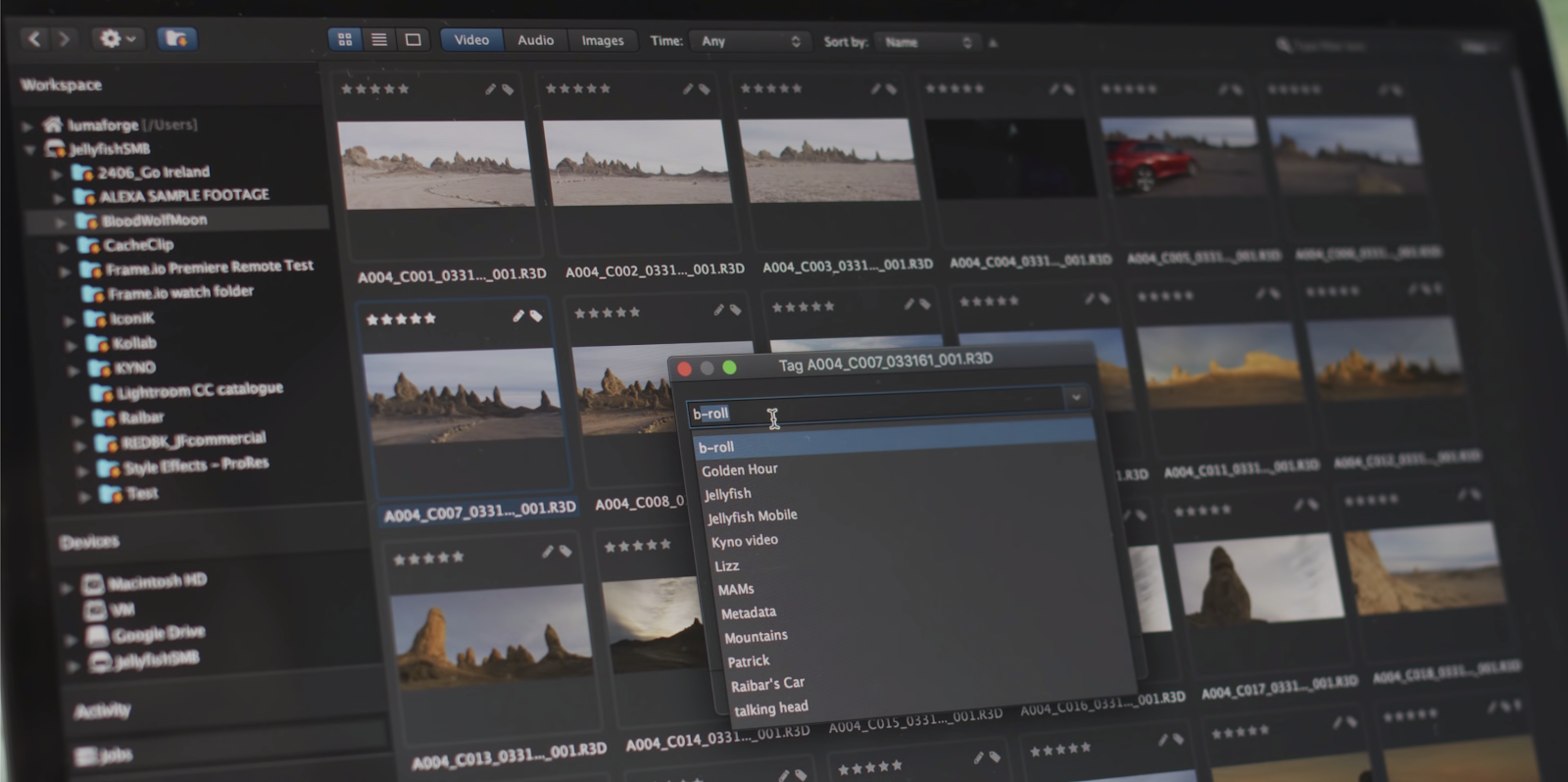
Metadata can come in the form of tags for a whole clip (like “b-roll,” “interview,” or “drone”) or so-called “time-based” metadata that lets you annotate specific time ranges in your content with descriptive metadata (like “mayor Jones sneezes at this point in the interview”). Once the metadata is entered, you can sort files by basically any technical or descriptive value you want.

Note that in many cases, metadata is lost, either because it was never captured in the first place, or it was removed/overwritten during a file conversion or transfer. The only way to get it back is to recreate it down the line, which comes at a very high cost. Any information about your material that is collected early in the life cycle (perhaps on location during or after a shoot) is relatively cheap, because it only takes a few minutes. When the people who actually know what happened in the shot or at the shoot are still accessible, they only need to make a few annotations, provided they have a suitable tool. But if the information is lost, it will take a lot more work to reconstruct it later (by people who were not on location) or it will just remain lost.

The role of “artificial intelligence” (AI) for metadata
AI is a label applied to a wide range of technologies and many of them yield incredible results today. For example, AI-based software can diagnose skin cancer from photos with much higher accuracy than the most experienced doctors. And some of these technologies are entering the video world, and are utilized in video metadata process. Imagine the time savings for your workflow if a machine could find key points of interest in clips, like shots from a soccer game where a goal is scored, or all shots of specific players from all the games in a season. These tasks can (and are) be automated.
Does AI satisfy all video metadata needs? Probably not if you need it any time soon. People are still far superior in the majority of tasks that a content editor typically does, like deciding on the mood of a scene or image according to a vocabulary standardized in your organization (imagine teaching a machine what should be tagged as “spectacular” or “romantic”).
AI will probably not replace humans in all metadata process for a few years (save some tremendous technological breakthrough), but it’s a good idea for organizations that could benefit from these tools to look at the developments coming down the road. As more real-world testing is completed, it makes sense to see how you can start using these tools sooner, so that your team can focus on more important workflow tasks.
Media management in video production and how we got here
In video productions, if an organized media management strategy isn’t set out in the beginning, the benefits of having one often become apparent too late, even in relatively small projects. As the production unfolds, bottlenecks become apparent, which then leads to a “we need to fix this” mentality. Even simple tasks like searching for (or even losing) content can unearth compatibility/technical problems in the workflow, which quickly become a massive productivity killer. This is why having a clear DAM strategy is so beneficial—it saves time, which saves money.
The simplest measures for DAM usually start at the bottom of the workflow, for example using an organized folder structure, standardized naming conventions and editing formats, and repeating processes the same way for each new project. This is more or less the definition of a “workflow,” but of course, we can go deeper.
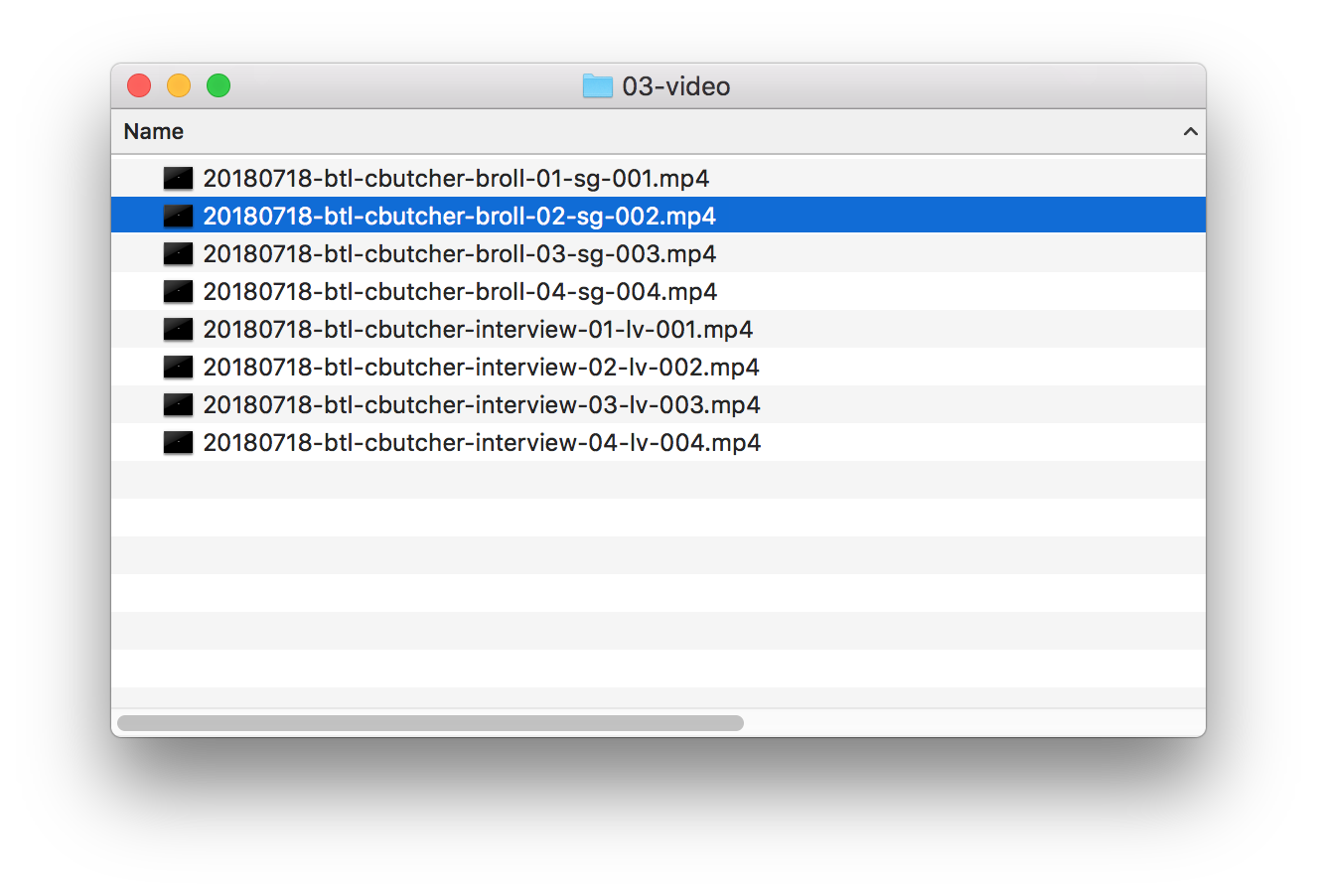
The need for some kind of organized approach grows exponentially with the amount of footage and team size. Larger productions and organizations have larger DAM needs. But there have been several developments in the media production industry and its drivers over roughly the past ten years that have further increased the need for effective DAM strategy.
Let’s make another quick digression to look at these developments:
- The move from film- and tape-based to file-based work made film/video production a more light-weight and flexible process.
- Advances in hardware and software technology made video editing accessible to millions more people.
- The digital camera revolution, i.e. cameras costing only a few hundred dollars that can produce an image quality suitable for professional TV and cinema productions. The lower system costs made it easier to capture more image variety and more angles, and thus more footage.
- The demand for more and more video content exploded with social media.
- The ubiquity of video in marketing for large and also smaller companies added to that. This resulted in more pressure to produce more content faster and for less money.
On top of that, another trend has made huge waves in the industry—traditional media organizations in the big broadcast networks and film studios have begun to adopt some of the lightweight production methods of new up-and-coming media stars, like YouTubers and run-and-gun filmmakers. Those smaller players, on the other hand, have become more professional in their production quality (because of the trends mentioned above).
Since the technologies and methods used by large and small production environments now have a massive overlap, they’re all dealing with the same task of managing their ever-growing volumes of media, which has increased demand for DAM tools that are more universal and easier to adopt. This convergence has also opened up a whole new world of industry-wide DAM best practices, with input from across the industry.
All this to say—it’s now easier, cheaper, and faster to implement a DAM strategy that matches your organization’s needs than ever before.
Finding the right DAM strategy
So then how should you formulate your DAM strategy? To start, here are a few things you’ll need to assess for your current and future production needs:
- Volume of Material – As camera systems continue to evolve at breakneck speed, more material from more sources will undoubtedly have to be dealt with. Not only does this influence how much storage you need, but it also means other processes, like quality-checking, will take longer. It also means there will be more potential for compatibility problems (“What camera did that freelancer shoot with? Why doesn’t the footage play/import in my software?”).
- Metadata Requirements – The more material you have, the more important the organization of metadata will become. If finding the right material takes a long time, it will cost you more further down the production chain. A few minutes of metadata logging in the beginning is worth many hours of searching later on.
- Scalability and Flexibility – Workflows are changing, and they won’t stop. Your DAM strategy will need to be dynamic and adaptable, and not rely on strict (or proprietary) processes. Anticipate more changes as the pace of new technologies or media channels continues to increase.
- Legal Review – For some organizations, managing the legal aspects of each piece of content is a crucial and time-sensitive challenge. You ensure that your legal review needs fit within the dynamic nature of your production processes, especially when different types of contributors are involved at every point. No one likes getting a project 99% to completion, only to have a lawyer say “we can’t do that, I should have seen this earlier.”
- Data Storage Cost – 4K is here and 8K is on the way. Plus 10-bit footage is becoming standard, while RAW footage is that wonderful tool we love to have but hate to pay for. Bitrates are increasing, so more and more storage will always be necessary. But storage costs money, and that means the cost of mismanaging media is only going to increase. Just imagine the cost of having unnecessary file duplicates, using inefficient storage infrastructure, or keeping unusable footage. It all adds up.
- Process Acceptance – Fast turnaround times for productions often make it difficult to enforce standards and processes, especially if they are perceived as burdensome. So, it’s critical that all team members (including freelancers and external production partners) buy in to a process, and have the appropriate training to use it effectively. This is a key factor to DAM strategy success, but can be one of the most difficult to manage.
- Content Reusability – As more distribution channels become available, each with their own specialized formats, it can be advantageous to adapt the same material to these disparate platforms. To ensure the maximum economic return for your organization’s DAM strategy, you will want to ensure it enables this sort of quick and flexible content reuse.
- Security and Survivability – Accidentally losing/deleting digital files is much easier than losing tapes. Your DAM strategy needs to encompass multiple aspects of redundancy, failure mitigation, and long-term stability. The added cost of these features is much smaller than the costs of redoing entire shoots, or replacing the revenue of lost contracts. On top of this, your DAM strategy needs to be future-oriented. Any data you capture now needs to survive well into the future. DAM systems have limited useful lifespans, so your strategy should address the minimum requirements necessary to move your organization’s data to the next system.
Once you’ve considered these aspects of DAM strategy, you’re well on your way to making an informed decision about your DAM system. However, there are a number of hidden costs that can really spiral out of control if they are not managed well. But to focus on the bright side, let’s think about the benefits of getting these right:
- Better DAM performance means more goals met. If your team has to waste less time on workflow processes, they can spend more time being creative.
- Better DAM reliability means less last-minute panic and long-term tension. No one likes losing material or clients. In general, up time correlates positively with team happiness.
- Better DAM organization means more room to grow. Teams and organizations can only scale as well as their processes and tools allow. Organized and robust DAM can set your team up for success.
- Better DAM flexibility allows you to adapt in the future. Making sure your processes are agile can help your organization sustain value for your clients, even as technology and media changes.
Requirements – what do you really need to do?
Requirements can vary wildly depending on your typical productions, your staff and what you do with the content later on. If you are building a large stock library, potentially even to monetize it, to become the next Getty Images, your requirements in terms of metadata management and searchability are typically very high. If all you want is an efficient team production process and to ensure that the project can be opened again if a client requests a new version, then those requirements are typically much lower because the main scope of media management tasks is just the individual project.
Getting requirements analysis right is key. If you choose an approach (and thus a system) that is overly complicated, you pay a price in higher costs getting simple things to work in a complicated environment. This also risks low acceptance by your staff. On the other hand, if you aim too low, you will find yourself building workaround after workaround, which at some point is likely to hit a wall. Looking at your needs should always encompass some scope into the future, so that you can meet future challenges. But beware, trying to cover too many bases can lead to scope creep, which will add more capacity at the cost of your timeline, budget, and end usability.
Big bang approach vs. small incremental steps
I have observed much more often that a complicated system led to effectively failed media management projects than a well-implemented simple system hitting its limitations. From my personal observation, the vast majority of production environments are probably still at a low level of organization (i.e. folder structures, naming, and format conventions at best). For most of them introducing very simple metadata management and searchability based on descriptions, keywords, ratings markers, and some simple automation, as well as a pragmatic archive and deletion policy would already be a leap in terms of organization level and productivity.
If you decide to start with a simpler solution, plan with the next stage in the back of your head to avoid dead ends, i.e. if you decide to start with a light-weight approach to metadata management with less “enterprisey” solutions, be able to answer the question “what will happen to all the (meta)data I invested time and money in, when I move to a larger system.” If you know your current solution does not block you from transferring that data and thus migrating your processes to the next larger system, starting small and seeing how it goes, improving incrementally, can go a long way, even for large enterprises.
Another factor that speaks in favour of starting with a simple (or at least staged) approach is people. It is hard to change habits, especially in an entire organization that has worked differently for a long time. Also, production environment time pressure is the silver bullet excuse for killing changes (“I’m not going to enter metadata into a database after the shoot, there’s simply no time for that”). The simpler and non-disruptive the introduction of a system is, the less work will be needed to get staff to comply with new policies and adopt new processes (as long as the chosen solution does the job, of course).
Questions to ask when choosing a system
So you’re ready to build a DAM system. Here’s a non-exhaustive list of helpful questions to test solution candidates against your strategy:
- Can I do what I want to do with the system for the foreseeable future?
- Do I need a central data pool or do people have their project or departmental or project “islands” and does the system support that well?
- What amounts of data (both in terms of storage space and number of assets) do I have to manage and what is the expected growth rate and are the chosen applications capable of handling that projected volume?
- Can the system deal with the load generated by concurrent use of a team size I expect for the planning horizon?
- Can the system deal with the file formats that are relevant in my space?
- How sophisticated must my metadata management be, i.e. descriptions, keywords vs. complex vocabularies/taxonomies and does the system support that?
- What applications or infrastructure must be integrated and are integrations available/possible in the respective workflows (check if all metadata relevant for your workflows survives the transition between systems)?
- How well does the solution integrate with what I already have in terms of hardware and software and other IT infrastructure including cameras and editing software?
- Do I need to manage editing projects in the system or is managing the files/assets enough?
- Will my workflow or costs benefit from being fully or partially in the cloud?
- What are the infrastructure requirements of such a system and the resulting infrastructure and administration costs?
- Do I need one comprehensive system that does everything or a more open, best-in-class combination of tools that interconnect/cooperate?
- Are the tools a good fit for the people (e.g. editorial staff is often not very comfortable with rather technical user interfaces, which can hinder adoption and ultimately make a project fail)
- Is there an upgrade path, i.e. a way to move on to a larger solution without losing all my investment (e.g. the metadata entered over years), when you grow out of the current solution?
- How open is the resulting system to future requirements (e.g. other systems to integrate with)?
- Does the vendor or their sales representatives have good answers to my concrete questions, convincing case studies from similar customers?
Summary
What you should take away from this article is that media management is a task you face, whether you want to or not. If you are working in video production, you are doing it already, if not consciously then odds are that you have a lot of potential for improvement, which is good. There’s a lot to gain from dealing with it appropriately, as the benefits and cost savings enable better growth for your team.
Whether it’s best for you to start with a lightweight solution like Kyno or with a mid-range MAM/DAM like Axle, CatDV or Cantemo, or an Enterprise cloud MAM like Veritone, or some combination of each category really depends on your current and future processes and business as well as your organization.
Asking the right questions in the decision-making process and knowing your organization, including its people, are key to implementing a DAM strategy that really delivers on the promises of this technology in your specific context. We hope that some of these tips and guidelines will help you on this challenging endeavor.

